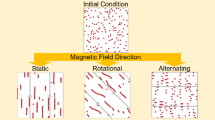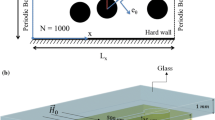Abstract
In the present study, we concentrate on the results of the unexpected characteristic that the stable particle cluster formation induces a decrease in the degree of heating effect in an alternating magnetic field, by means of Brownian dynamics simulations. If chain-like clusters are stably formed in the system, whether or not a large heating effect is obtained is dependent on the magnitude relationship between the magnetic particle-particle and the magnetic particle-field interaction strengths. As the magnetic particle-particle interaction strength increases and becomes more dominant than the influence of the magnetic field, the magnetic moments of stable chain-like clusters do not have a sufficient tendency to inline in the field direction. This leads to a smaller area of the hysteresis loop, and therefore the stable cluster formation induces a significant decrease in the heating effect.

Graphical abstract





Similar content being viewed by others
References
Häfeli U, Schütt W, Teller J, Zborowski M (1997) Scientific and clinical applications of magnetic carriers. Springer Science, New York
Schmidt AM (2007) Thermoresponsive magnetic colloids. Colloid Polymer Sci 285:953–966
Kumar CSSR, Mohammad F (2011) Magnetic nanomaterials for hyperthermia-based therapy and controlled drug delivery. Advan Drug Delivery Rev 63:789–808
Obaidat IM, Issa B, Haik Y (2015) Magnetic properties of magnetic nanoparticles for efficient hyperthermia. Nanomaterials 5:63–89
Golovin YI, Gribanovsky SL, Golovin DY, Klyachko NL, Majouga AG, Master AM, Marina S, Kabanov AV (2015) Towards nanomedicines of the future: remote magneto-mechanical actuation of nanomedicines by alternating magnetic fields. J Control Release 219:43–60
Bruce IJ, Sen T (2005) Surface modification of magnetic nanoparticles with alkoxysilanes and their application in magnetic bioseparations. Langmuir 21:7029–7035
Girginova PI, Daniel-da-Silva AL, Lopes CB, Figueira P, Otero M, Amaral VS, Pereira E, Trindade T (2010) Silica coated magnetite particles for magnetic removal of Hg2+ from water. J Colloid Interface Sci 345:234–240
Rosensweig RE (2002) Heating magnetic fluid with alternating magnetic field. J Magn Magn Mater 252:370–374
Zhao Z, Rinaldi C (2018) Magnetization dynamics and energy dissipation of interacting magnetic nanoparticles in alternating magnetic fields with and without a static bias field. J Phys Chem C 122:21018–21030
Satoh A (2003) Introduction to molecular-microsimulation of colloidal dispersions. Elsevier, Amsterdam
Allen MP, Tildesley DJ (1987) Computer simulation of liquids. Clarendon Press, Oxford
Satoh A (2010) Introduction to practice of molecular simulation: molecular dynamics, Monte Carlo, Brownian dynamics, lattice Boltzmann and dissipative particle dynamics. Elsevier, Amsterdam
Satoh A (2017) Modeling of magnetic particle suspensions for simulations. CRC Press, Boca Laton
Author information
Authors and Affiliations
Corresponding author
Ethics declarations
Conflict of interest
The authors declare that they have no conflict of interest.
Additional information
Publisher’s note
Springer Nature remains neutral with regard to jurisdictional claims in published maps and institutional affiliations.
Highlights of the present paper
(1) We focus on the results of the unexpected characteristic that the stable particle cluster formation induces a decrease in the degree of heating effect.
(2) The degree of heating effect is dependent on the magnitude relationship between the magnetic particle-particle and the magnetic particle-field interaction strengths.
(3) With the magnetic particle-particle interaction being more dominant, the area of hysteresis loops of the field-magnetization curves becomes smaller, leading to poorer heating effect.
(4) In the opposite case, the magnetic moment of each constituent particle is able to sufficiently respond to the change in the magnetic field, leading to a better heat production.
(5) Significant heat production can be achieved in the situation where large chain-like clusters are formed and inclined in the applied alternating magnetic field.
Appendix
Appendix
Figure 6 shows results of the dependence of potential curves on the magnetic particle-particle interaction strength for the two cases of λ = 10 and 16, where the common steric interaction strength of λV = 150 is used. In the figure, Um* and UV* are the non-dimensional magnetic particle-particle and steric repulsive interaction energy based on the thermal energy kBT, respectively, and U* is the total interaction energy as U* = Um* + UV*. A representative snapshot of particle aggregates is also shown in the figure for each case of the magnetic interaction strength for reference. It is noted that the magnetic particle-particle interaction energy is evaluated under the assumption that the magnetic moments of the two magnetic particles of interest incline in the same direction along the line connected between the centers of the particles, and the abovementioned energies are evaluated as a function of the non-dimensional distance between the two particles, rij* (= rij/d). The cluster formation is mainly governed by the depth of a potential curve, and if the depth is much deeper than thermal energy kBT, stable clusters more strongly tend to be formed in the system. The depth of the potential curve is U* = −9.12 and − 14.7 at rij* = 1.295 and 1.29 for λ = 10 and 16, respectively. Since these depths are much deeper than unity (i.e., thermal energy), the snapshots exhibit significantly similar network (chain-like) clusters between these cases, but slightly clearer network structures are recognized in the case of λ = 16. Moreover, it is noted that the minimum energy in each net potential energy arises in close vicinity to the contact surface of the steric layer (i.e., rij* = 1.3)
Dependence of potential curves on the magnetic particle-particle interaction strength for the two cases of λ = 10 and 16, where the common steric interaction strength of λV = 150 is used. The distance giving rise to a minimum energy in each net potential energy is in close vicinity to the contact surface of the steric layer. Snapshots are not significantly different between these two cases, but slightly clearer network structures are observed for λ = 16 than for λ = 10
Figure 7 shows results of the time change in the system energy to a steady state situation for the case of RB = 5 in no applied magnetic field ξ = 0, where results are shown for the magnetic interaction strengths λ = 10 and 16. Two representative snapshots of particle aggregates are also shown in the figure at the cycle number of Ncycl = 5 and 25 for each case of the magnetic interaction strength in order to assess the rate of the convergence. From the results regarding the change in the system energy, it is clearly evident that the convergence to a steady-state situation is approximately accomplished in an early stage of the simulation steps, at Ncycl ≃ 10 and 5 for λ = 10 and 16, respectively. Moreover, it is seen that there is no essential difference between the snapshots at Ncycl = 5 and 25 for both the cases. The snapshots in the figures are essentially quite similar to those for thermodynamic equilibrium in no applied magnetic field in Fig. 6. However, it is recognized that slightly looser network structures are formed in the case of an alternating magnetic field (Fig. 7) since in this case, the viscous forces and torques function to decrease the stability of network clusters. These characteristics may clearly validate the accuracy of the present results in respect to the snapshots, the hysteresis loops, and so forth.
Time change in the system energy to a steady-state situation for the case of RB = 5 in no applied magnetic field. The convergence to a steady-state situation is accomplished in an early stage of the simulation steps, at Ncycl ≃ 10 and 5 for λ = 10 and 16, respectively. There is no essential difference between the snapshots at Ncycl = 5 and 25 for the both cases
Figure 8 shows the dependence of potential curves on the steric repulsive interaction strength for the common value of the magnetic interaction strength, where two representative cases of λV = 100 and λV = 200 are addressed: Figs. 8 a and b are results for λ = 10 and λ = 16, respectively. A representative snapshot of particle aggregates in thermodynamic equilibrium is also shown in the figure for each case of the steric repulsive interaction strength for reference. The method of evaluating the magnetic particle-particle interaction energy has already been described in Fig. 6. Although in the Brownian relaxation mode of the magnetic moments the surface roughness may be expected to have an influence on the heating performance, it seems to be reasonable to consider that the structure of network clusters is essentially the dominant factor for determining the motion of the network clusters in the situation of an alternating applied magnetic field. This is because these clusters are stably formed in the system due to magnetic interactions under the influence of the disturbance of an alternating field in the present cases of λ = 10 and λ = 16, not due to the surface roughness of magnetic particles. Hence, we here discuss the influence of the steric repulsive interaction strength λV on the potential curves and particle aggregates; a larger value of λV implies a more numerous number of surfactant molecules, i.e., a larger value of the number density ns. The depth of the potential curve is U* = − 9.15 and − 9.08 at rij* = 1.285 and 1.295 for λV = 100 and 200, respectively, in the case of λ = 10, and similarly, U* = − 14.76 and − 14.61 at rij* = 1.285 and 1.295 for λV = 100 and 200, respectively, in the case of λ = 16. It is seen that the energy depth is not strongly dependent on the value of the steric repulsive interaction strength λV for both the cases of λ = 10 and 16. This characteristic clearly exemplifies that the snapshots of particle aggregates are not significantly different among those for the three cases of λV = 100, 150, and 200
Dependence of potential curves on the steric repulsive interaction strength for the common value of the magnetic interaction strength, where two representative cases of λV = 100 and λV = 200 are addressed: Figs. 8 a and b are results for λ = 10 and λ = 16, respectively. A representative snapshot of particle aggregates in thermodynamic equilibrium is also shown in the figure for each case of the steric repulsive interaction strength for reference. The energy depth is not strongly dependent on the value of the steric repulsive interaction strength λV for both the cases of λ = 10 and 16, which clearly exemplifies that the snapshots of particle aggregates are not significantly different among those for the three cases of λV = 100, 150, and 200
Rights and permissions
About this article
Cite this article
Suzuki, S., Satoh, A. Influence of the cluster formation in a magnetic particle suspension on heat production effect in an alternating magnetic field. Colloid Polym Sci 297, 1265–1273 (2019). https://doi.org/10.1007/s00396-019-04546-x
Received:
Revised:
Accepted:
Published:
Issue Date:
DOI: https://doi.org/10.1007/s00396-019-04546-x







